The Hoh Rain Forest is at the northwest corner of Olympic National Park in northwestern Washington. This place is wet. Wet is an understatement in a rainforest, but for us, during our visit, because we timed it in September, it never rained. I am very glad that we were able to visit without the threat of multiple-day downpours.

Some people recommend visiting during the rainy season (not me). More moisture probably makes the moss and forest floor more vibrant. If this is attractive to you, then November might work. In November they get more than twenty inches of rain. I don’t recommend visiting in November. In November you can expect heavy nonstop rain every day. I’m not camping in heavy nonstop rain if I can help it.

About that name
The word “Hoh” undoubtedly comes from Native American languages; possibly the Quileute word “Ohalet” which means fast-moving water. However, the relationship is uncertain. The pronunciation is the same as the garden tool, “hoe”.
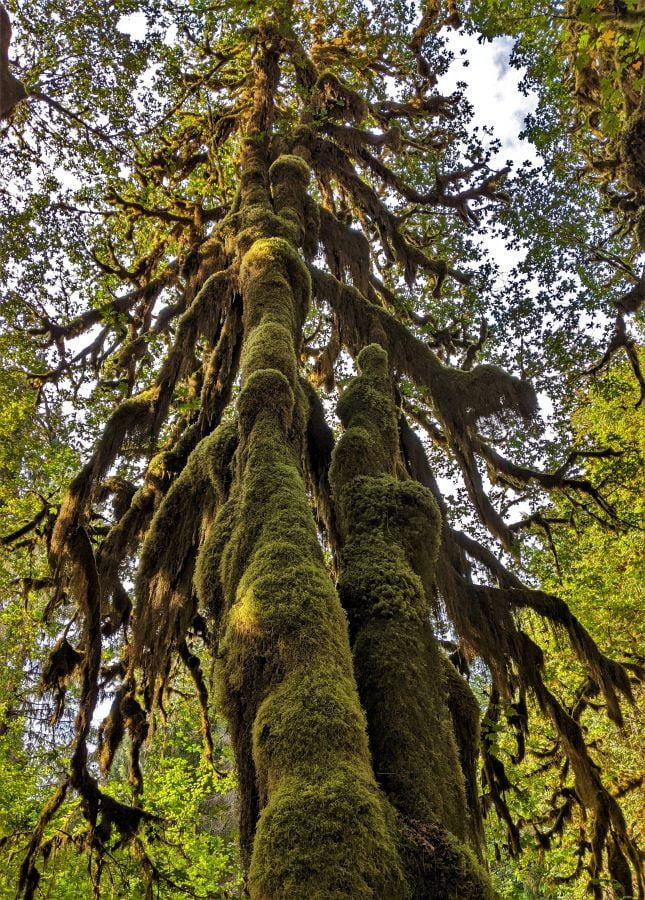
About that spelling
Since I was working from memory, I had spelled the name Hoh Rain Forest as one word. Then I found out that the National Park Service spells the word rainforest as two different words. Thus the Hoh Rain Forest is their correct spelling.
From Rainforest to Rainforest
Starting in the southeastern states, we have been in rainforests a lot during the last two years of travel. A rainforest is a location that gets more than 2-3 inches of rain each month. Most of my rainforest time prior to the last two years was in the Philippines. Maybe there is a dry location in the Philippines but I never found it.

The Everglades in southern Florida by definition is a rainforest. Mostly I just called it a swamp. We spent nearly a month in the Everglades as we worked our way south and then north through Florida on our way to Key West. I think of the Everglades as a gator-infested swamp, but it is also a tropical rainforest. The Hoh Rain Forest is a temperate rainforest. It does not have the high temperatures found in the Everglades. Here is a link to one of our stories about the everglades. Deep in the Everglades
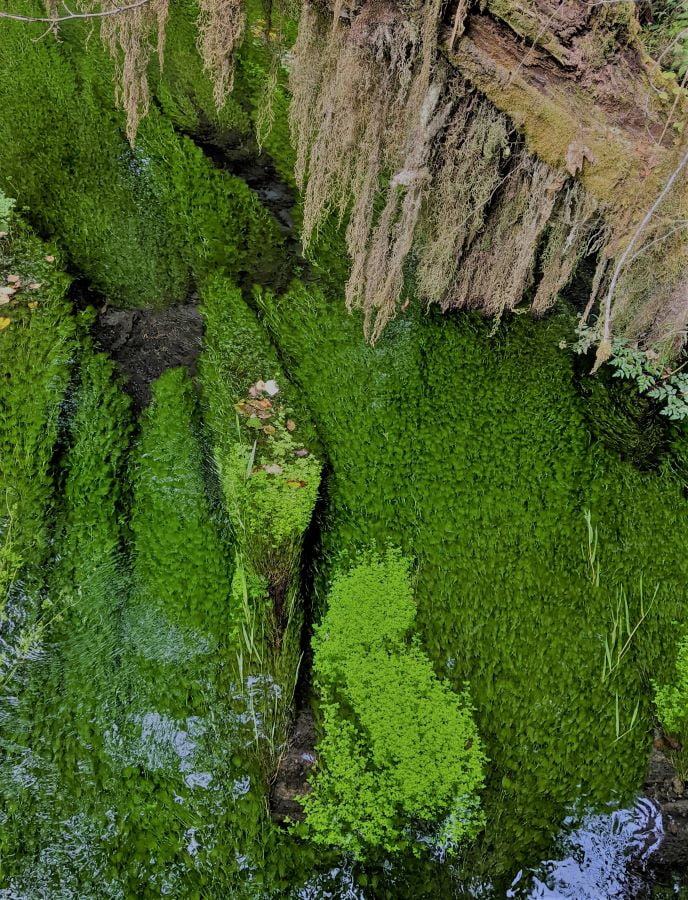
Across the South
By definition, much of the southern United States also qualifies as a rainforest and we spent most of last year in the southern United States. The southern states including the Smoky Mountains qualify as a rainforest based on the total monthly rainfalls. We don’t think of the southern United States as a rainforest (except perhaps the swamps). Instead, we think of the southern United States as farmland.

You could say that in the last eighteen months we went from rainforest to rainforest except as we crossed the great plains, deserts, and mountain ranges. No one would debate that the Everglades and the Hoh Rain Forest are true rainforests.
Lots of rain
The Everglades average about sixty inches of rain per year. The Hoh Rain Forest gets more than twice that much. By far, the Hoh Rain Forest is the wettest location in the lower forty-eight states that we have visited.

Perhaps some locations in Alaska get more rainfall than Hoh. Sitka in Alaska gets similar rainfall totals. Parts of Maui and especially Kauai get about the same rainfall as the Hoh Rainforest.

Mount Olympus, uphill from the Hoh Rain Forest, gets almost twice as much rain as the Hoh Rain Forest. Similarly, Mount Waialeale in Kauai gets about three times the annual rainfall of the Hoh Rain Forest. As a note, the Olympic Rain Shadow is only about forty miles (as a crow flies) to the west of Hoh. I explained the Olympic Rain Shadow in this post. Olympic Rain Shadow
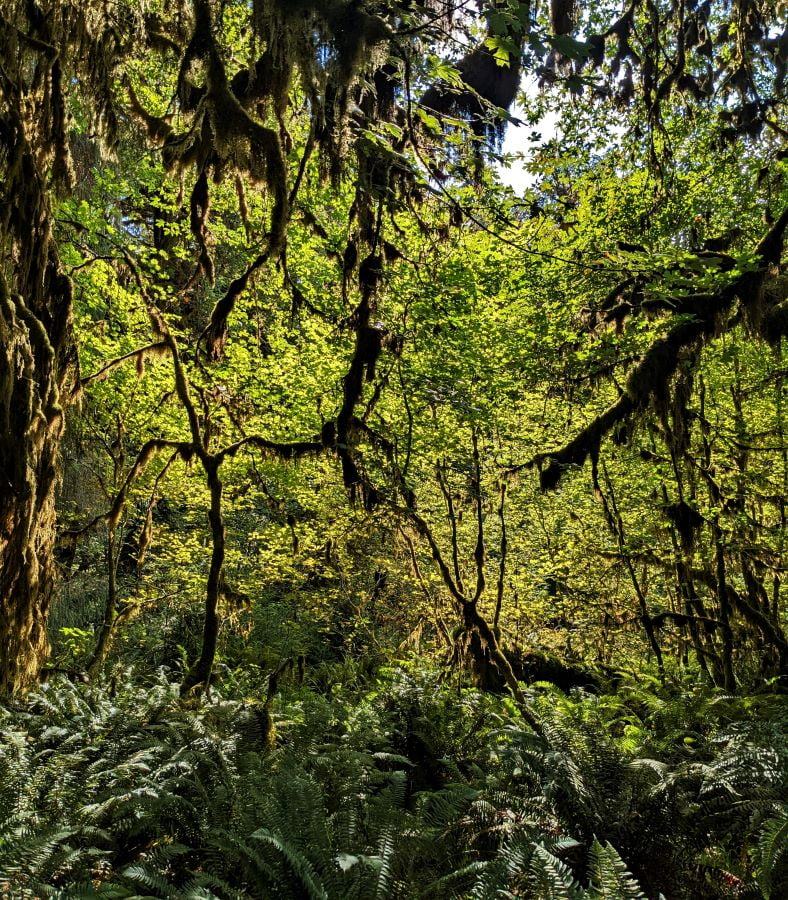
Olympic National Park
The Hoh Rain Forest was our third visit to the park and one of the two places we camped in the park. We camped at the Hoh Rain Forest for four days followed by another three days camping on the beach in the park at the Kalaloch Beach campground overlooking the Pacific Ocean. On our first visit to the park, I covered Hurricane Ridge and the mountains on the north side of the park in this story. Hurricane Ridge

On our second visit to the park, we paddled our kayaks on a beautiful lake. Here is a link to that story. Lake Crescent As you might imagine our next story will be about our stay at Kalaloch Beach.

What we found
What we found in the Hoh Rain Forest was overwhelming green. As you can see in the top picture and almost every other picture nearly everything is green. Moss covers most of the tree bark with a thick green living carpet. In the shadows some of the roads were green, covered with green algae. We were lucky to have blue skies during our visit.

I guess you have to say that two other things in the Hoh Rain Forest are not green. One was the banana slugs. These slime sticks are about the same size as a small banana. We didn’t see any and even if we did, I probably wouldn’t have taken a picture. Banana slugs crawl right on the trails. Be careful where you step. Banana slugs eat decomposed vegetation on the forest floor.
Fungi

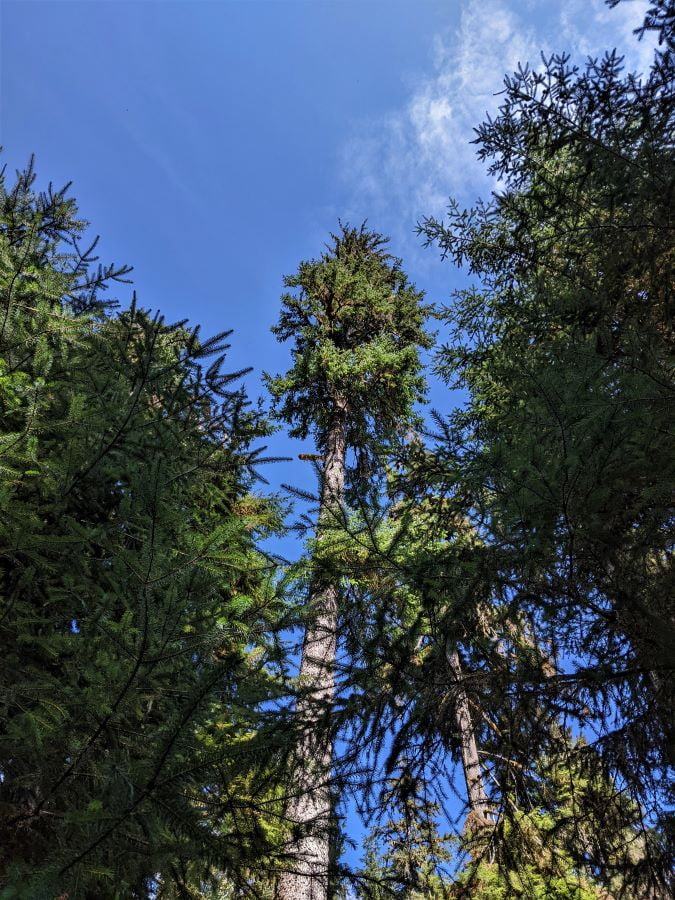
Under the tree canopy, there is plenty of shade. Some locations never have direct sunlight. The sunlight at the Hoh Rain Forest typically doesn’t get to the forest floor. Even in the dry season, the forest floor is moist and green. If you see dirt, it will be wet dirt (mud). The number one plant we saw on the forest floor was ferns. Ferns were everywhere, sometimes we saw them high in the trees.
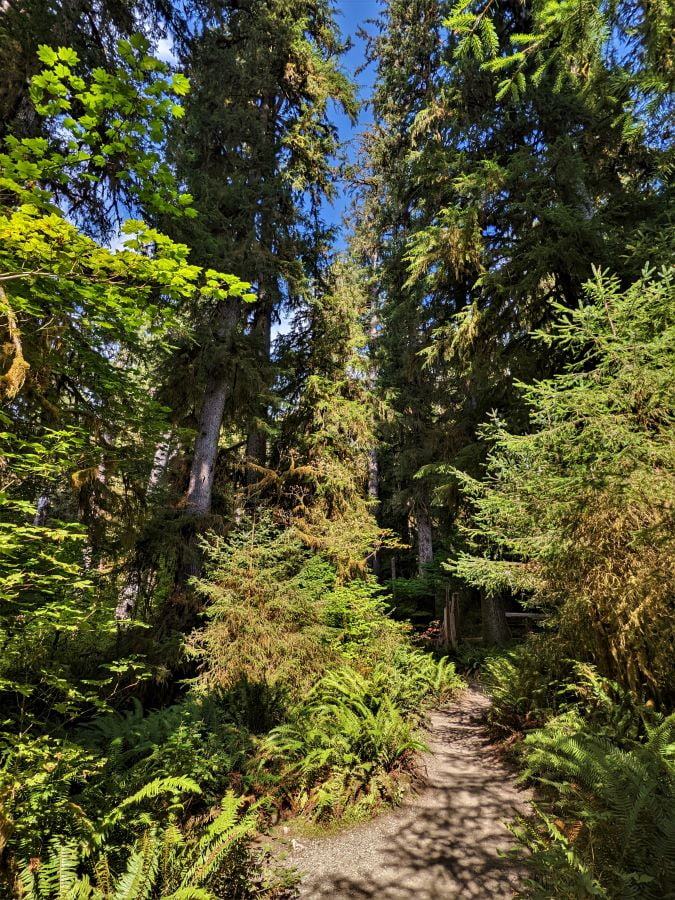

Roosevelt Elk
If you go to the Hoh Rain Forest in the summer you may not see the elk. As the snow melts in the spring, the elk follow the receding snowline high into the mountains. In the fall and winter, the elk return to the lower elevations back into the rainforest. On our first evening, we saw and heard the elk in the river bed right next to the campground. They were quite vocal.
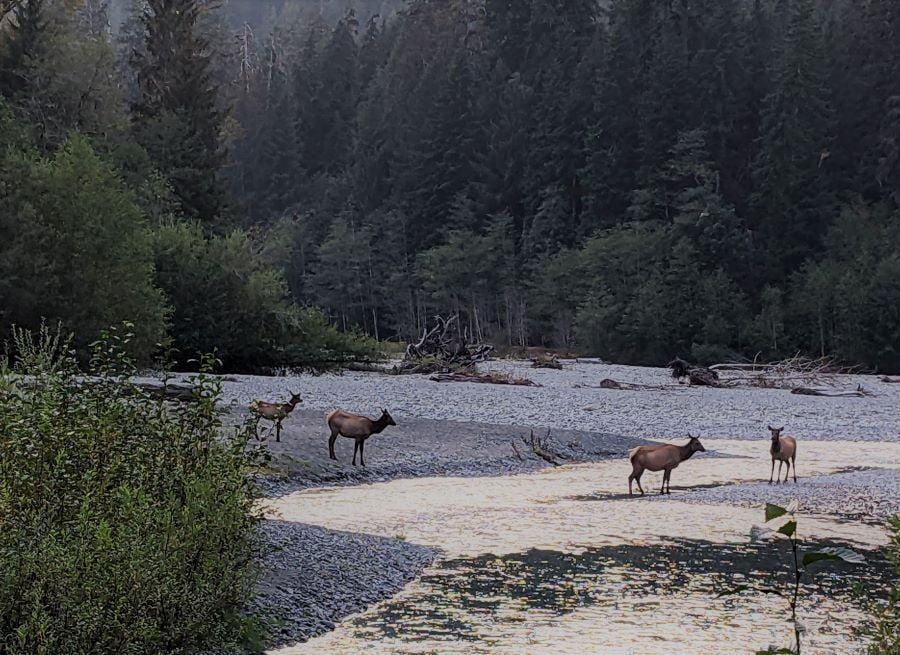

I took the previous two pictures after sunset while the sky was still bright. Since I was using a cell phone I had to crop them to get the animals big enough to be the subjects of the photos. The cropping kind of makes the colors blur.
At the end of the week, the new lonely bachelor bull wandered through the campground more than once. Tami took this picture of him wandering from a campsite toward the visitor’s center. Eventually, the ranger chased him back down to the riverbed. The rangers try to keep the elk away from the people, especially during the rut.

Recommendations
We loved visiting the Hoh Rain Forest. Assuming you visit in the two driest months of August and September abundant rain shouldn’t be an issue. If however, you go in the spring, including June you may have some problems with the rain, snowpack, and mud. The park closes some of the campsites in the campground sites when the river rises in the spring. Overall, we really enjoyed it and recommend it.
Our visit to Olympic National Park
Quinault Rainforest and Kestner Homestead
Please subscribe and join us on our journey
We will add you to our email list and send you updates about once a week. Here is a link. Subscribe


So, you mentioned in passing the Philippine rain forests you had experienced earlier….does VC-5 hold any meaning for you?
I have friends who flew with the Checkertails both flying the helicopter and scooters. Interesting squadron. My time in the Philippines was flying the Seahawk. I spent plenty of time hunting for remote waterfalls high in the mountains. Beautiful.
Great pictures. Note taken about the time to visit. Ninette likes to find those interesting mushrooms. They are pretty cool. Just goes to prove that with enough water things can grow anywhere. It is crazy how mother nature takes care of itself. Thanks for sharing.
Hi Scott and Tami, as usual your photos and blogs are outstanding. I really enjoy the photos and descriptions of the places you have visited. How much longer are you going to continue with your adventure?
Jan and I are getting ready to settle down, not by choice though. Jan has come down with early dementia, we are looking for a place to rent in Lubbock, TX, if I can convince her. You two take care of each other and be safe.
Love the photos and info.
Lynda and I really enjoyed this article.
Your photos are great! Lynda grew up in the Seattle area and made sure we visited the Hoh Rain Forest and Hurricane Ridge.
Your article took us back to a great trip (not as long a stay as yours, but like yours, without rain:-)
Steve
I have several responses for you two.
The crop of your cell phone images (elk) resulted in an impressionistic painting texture, very wonderful. Wondered what the bright green image to the left of the elk was, abstract-like.
I was in a Spring camp area Mt. Rainier not aware of sudden melt flash floods… 90 seconds to get to higher ground! An eye-opener to say the least.
Hiked out and up to and on to snow/ice-covered ridges. Striking views. I remember reflective deep clear cold waters…
Wonderful images you captured!
The green was a leaf closer to the camera that I didn’t crop out of the picture.
using Google Maps, I looked up the Hoh Rain Forest…there are no roads by the visitor center! How did you…
The road is named the Hoh Valley Road or the Upper Hoh Road. Depending on the map. The parking lot is just south of the Visitors Center.
Pingback: It is beautiful in Whittier - FoxRVTravel
Pingback: The Charm of Port Townsend - FoxRVTravel